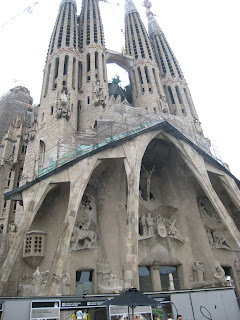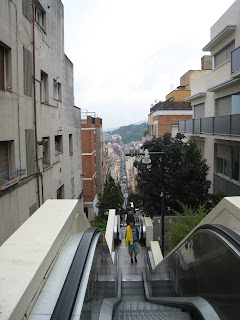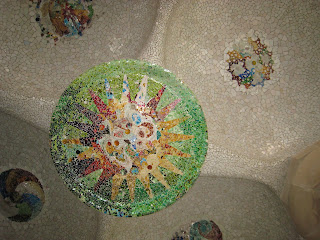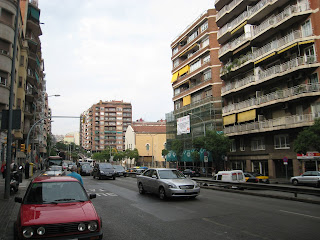Can Eusebio Restuarant in Barcelona, nice Spanish cuisine.
La Sagrada Familia
The Basílica de la Sagrada Família, also known as the Sagrada
Família, is a large unfinished Roman Catholic minor basilica in the
Eixample district of Barcelona, Catalonia, Spain. Designed by the
Spanish architect Antoni Gaudí, his work on the building is part of a
UNESCO World Heritage Site.
The basilica is scheduled to be completed in 2027, 145 years after its construction in 1882
Walk to Park Güell, is about 2km from La Sagrada Familia
Parc Güell is a privatized park system composed of gardens and
architectural elements located on Carmel Hill, in Barcelona, Catalonia,
Spain. Carmel Hill belongs to the mountain range of Collserola – the
Parc del Carmel is located on the northern face.
Park Güell is an enormous garden with stunning and distinct architectural elements designed by
the renowned Catalan architect, Antoni Gaudí. The Park is named after
Eusebi Güell, a rich entrepreneur and count that had a great passion for
Gaudí's work and who became his patron
Park Guell Entrances
Built between 1900 and 1914, it was inspired by the ‘garden city movement’ of the 20th
century. Built on the edge of the city, this allowed the park and the
self-contained communities within it to be surrounded by both clean air
and green open spaces. Designed by Catalan architect Antoni Gaudí and
named after sponsor Count Eusebi Güell, the estate remained Gaudí’s
family home until his death in 1926. From then on, Park Güell became a
public space, which still attracts millions of annual visitors today
Serpentine bench
The Serpentine Bench is a well-known mosaic tile bench that winds its
way along the terrace around Park Güell. It was created using the
Trencandís technique, which was invented by Gaudí and was widely used
during Catalonia’s modernism and surrealism periods. Created in a
signature serpentine shape and varying vibrant tones for a statement
effect, the bench was designed using jettison tiles from a factory close
by. Both artistic and functional, rest and take in the beauty of the
park in style at the Serpentine Bench.
Sala Hipostila, or the Hypostyle Room.
Originally designed in 1907 as the marketplace of the estate, the
Hypostyle Room is made up of 86 columns which the roof rests upon.
‘Hypostyle’ itself means ‘under pillars’, and the design is used for the
creation of large constructions, such as public buildings, temples and
palaces. The pillars present a height of 19.68 feet (6 metres) and a
diameter of 3.94 feet (1.2 meters), and are of the Doric order in an
octagonal shape. The ceiling is the focal point of the Hypostyle Room,
showcasing all-over white Trecandís, spiral designs and four circular
ceiling lamps that represent each season of the year. An effortless
statement in design, it’s essential to see on a visit to the park.
Ceiling with mosaic sun
Multicolored mosaic salamander fountain known also as el drac or dragon
The mosaic salamander statue that resides at the gates of Park Güell
acts as the symbol of Barcelona. ‘El Drac’ is known by multiple names,
such as ‘the dragon’ and ‘the Park Güell lizard’. Acting as a guard for
Park Güell, it was created from brick and is coated with Gaudí’s
signature Trecandís technique. Trecandís and serpentine shapes are
common themes throughout Gaudí’s work, and Park Güell is an ideal
location to see and enjoy both.
The Laundry Room Portico
Constructed in a slanted shape, the Laundry Room Portico was designed to
mimic an ocean wave. Created with textured walls and coordinating
statues throughout, the pillars at the exterior were put in place in
order to secure the road above. Gaudí used this design to blend his
creativity with the surrounding natural environment. The passages
throughout were designed to connect houses to each other subtly, with
their textured finish blending into the hillside. Visit the Laundry Room
Portico to bask in the shade of the Spanish sun, as well as to witness
innovative Catalan architecture at its finest.
Hotel Vela from Barceloneta Beach.
Raining day no visitor today
1st day in Brceloneta without visitor
Mercado de La Boqueria
The Mercat de Sant Josep de la Boqueria, often simply referred to
as La Boqueria, is a large public market in the Ciutat Vella district of
Barcelona, Catalonia, Spain, and one of the city's foremost tourist
landmarks, with an entrance from La Rambla, not far from the Liceu,
Barcelona's opera house.
Catedral de Barcelona (Cathedral of the Holy Cross and Saint Eulalia)
Built between 1298 and 1420, the cathedral is dedicated to Saint
Eulalia, patron saint of the city of Barcelona, who was buried in the
crypt of the cathedral. This imposing cathedral is one of the most beautiful in Barcelona.
Gothic in style, it’s full of details and reliefs, both inside and
outside. Among the many elements worth visiting, the cloister always
attracts attention because of the 13 white geese that represent each
year of Eulalia’s life before she suffered martyrdom.
Bank of Spain
Casa Milà
Casa Milà was the last building designed by Gaudí before he spent his remaining years on La Sagrada Família. The building, a residential complex in Eixample is an incredible stone building designed in the Modernisme style of Catalunya.
Stonemasons carved the building into irregular shapes with large curves and waves, and iron ornamentation. In comparison to his other works, Casa Milà is colourless from the outside, giving it a more intriguing quality.
In the attic, there is a room dedicated to Gaudí’s architecture. However, the biggest draw is the roof. With panoramic views over the city, the roof also features ornately designed chimneys, ventilation shafts and staircases.
Casa Batlló
Casa Batlló is one of the 2 villas designed by Gaudí on the Passeig de Gracia. Also named the Casa del Ossos (“House of Bones”) by the locals, Casa Batlló is a true jewel of architecture and engineering that seems to have come straight out of a fairy tale. Listed as UNESCO World Heritage Site, the building’s undulating façade and kaleidoscopic mosaics make it one of the most emblematic and visited places in Barcelona.
Nice Smart Fortwo 451 Cabrio and Coupe
Barceloneta Beach




















































































































No comments:
Post a Comment